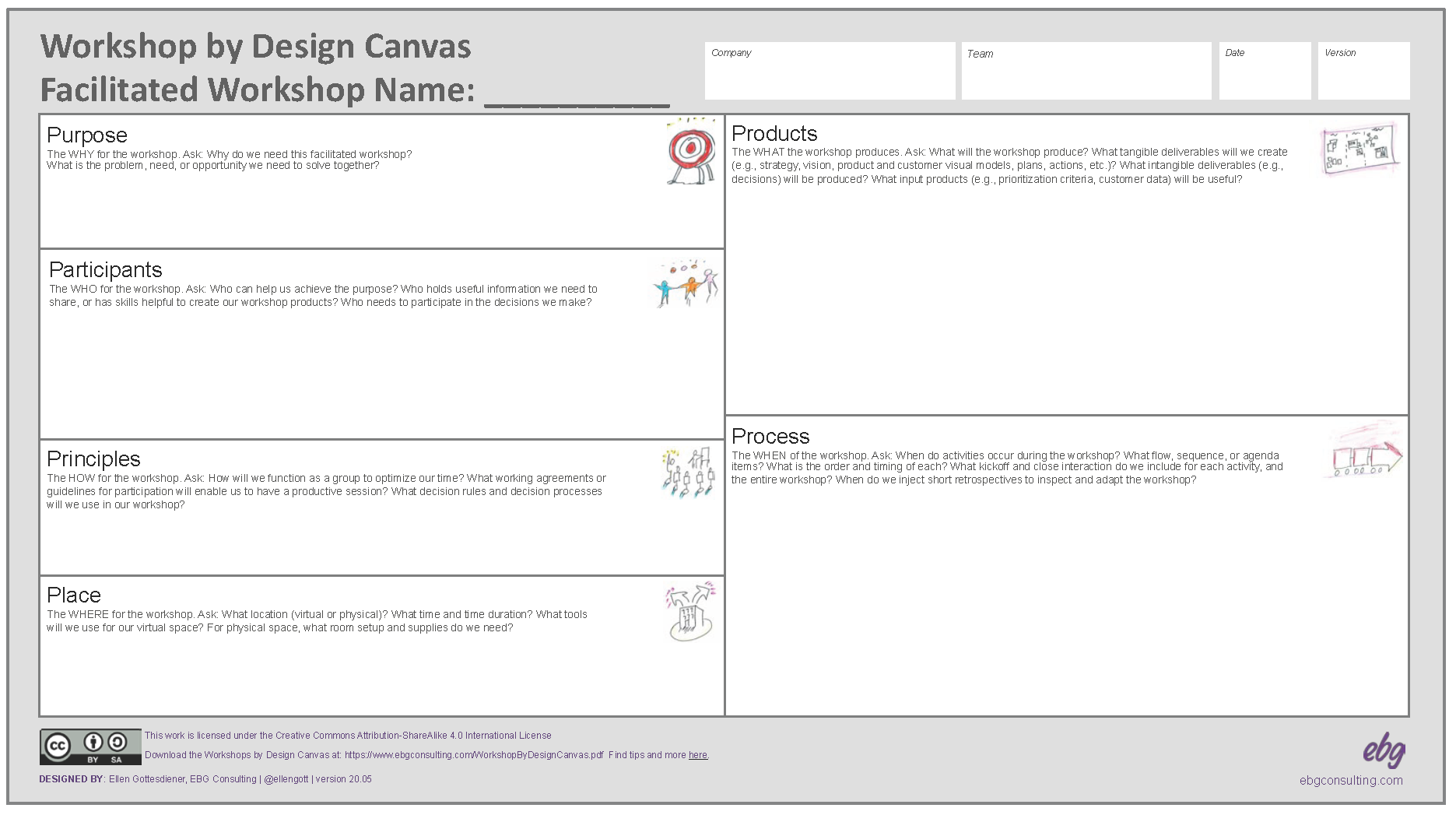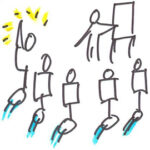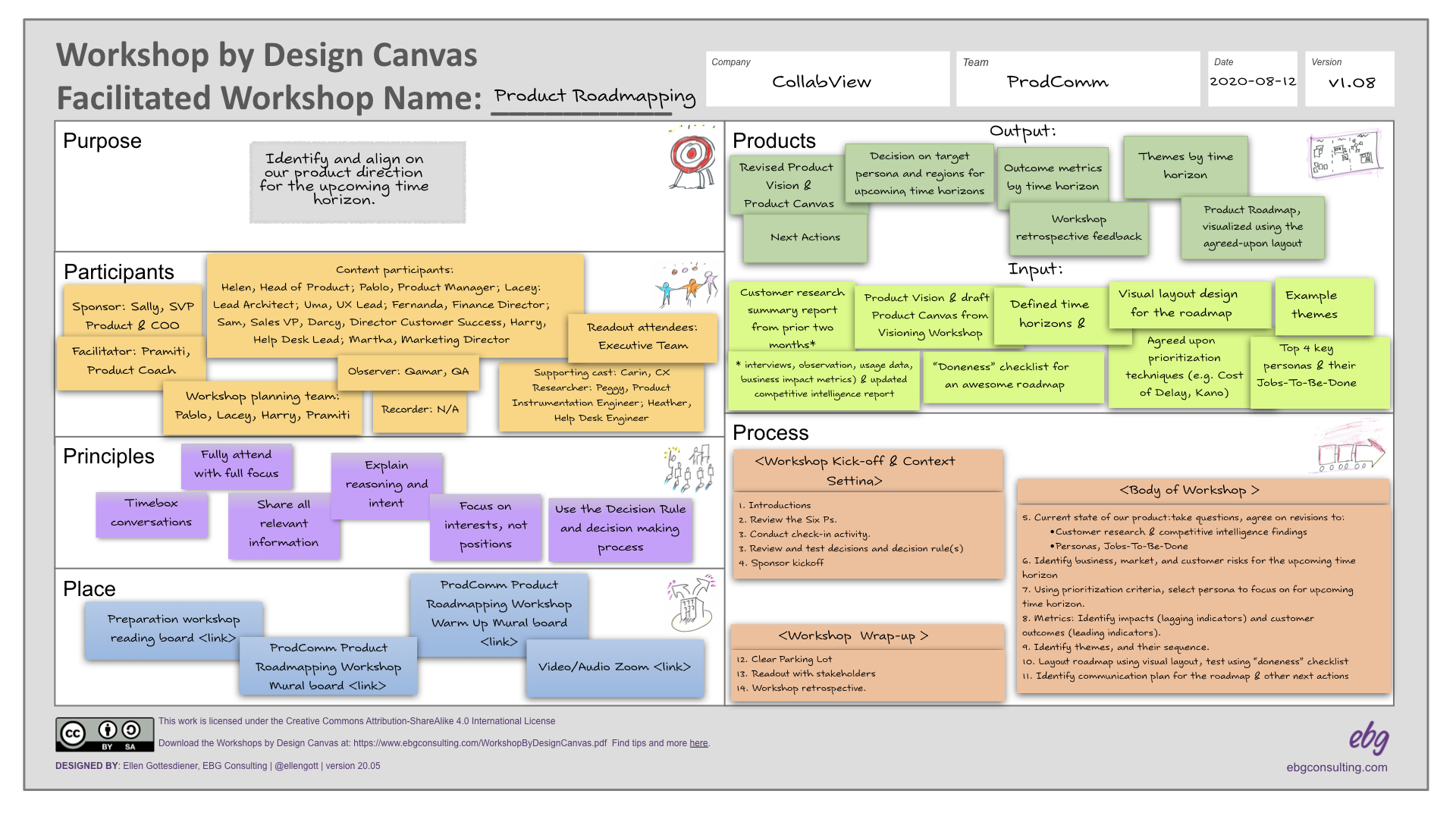Workshop by Design Canvas: Making Collaboration Work
The heart of successful product management and product development is a collaborating community of team members operating with shared goals, mutual trust, and learning mechanisms for evolving products and processes. I have found one of the best ways to create a healthy product community is with facilitated workshops.
These workshops are usually driven by product management requiring buy-in of multiple work products including:
- Clearly defined product vision, goals, strategy, and quantifiable customer outcomes
- Market research results, competitive analysis, and pricing strategy
- User research and product discovery plans and findings
- Product roadmap, release and launch plans, and ongoing retrospectives
After defining what a workshop is, you’ll learn how to use the Workshop by Design Canvas to help your product organization improve collaboration.
What Are Workshops?
A workshop is an event that includes a carefully selected group of product stakeholders and content experts who work together to explore, define, create, correct, and decide upon deliverables and work products. A workshop goes well beyond a meeting. Meetings typically involve information exchange and often involve little or limited participation.
Workshops (facilitated workshop, collaborative workshop, or design session) should offer a rich learning experience. A successful workshop needs to be structured, having a standard set of attributes where participants:
- Join together to create work products designed to achieve shared goals
- Agree ahead of time on the work products to be discussed in the workshop
- Define and use a decision-making rule and process
- Follow an agreed-upon process and agenda
- Use visual tools that ignite diverse views and encourage creative thinking
- Have the right mix of skills, experience, and knowledge to produce and reach closure on work products interdependently
But active workshop participation doesn’t “just happen.” Collaboration must be designed into the workshop. How can a workshop be designed to tap into the collective wisdom of a product team? The key is preparation.
The Six Ps and the Workshop by Design Canvas
To design a collaborative workshop, define using what I call the Six Ps: purpose, participants, principles, products, place, and process. [1, 2] These six elements provide a framework for designing a successful workshop, regardless if it is held live in a conference room or virtual.
The Workshop by Design Canvas is a visual tool for using the Six Ps. It helps the team answer the purpose (why), participants (who), principles (how), products (what), place (where), and process (when) for any workshop to be successful:

Source: EBG Consulting | Workshop by Design Canvas | Download the Workshop by Design Canvas
Filling out each of the Six Ps on the canvas for a product roadmapping workshop is described below:
 Purpose (the Why for Having the Workshop)
Purpose (the Why for Having the Workshop)
Description: Summarize a brief description of the reason the workshop is being held.
Rationale: The workshop purpose outlines the reason and justification for the workshop. It explains why the workshop is being conducted and serves as a frame of reference. Don’t undervalue the benefits of a well-defined yet straightforward statement of purpose.
Tips:
- Limit the purpose to three or fewer sentences, keep it short and sweet.
- Avoid listing the workshop’s products.
- Always ensure that the purpose is understood, shared, and motivating to all participants.
- Ask the following questions:
- Why do we need this facilitated workshop?
- What is the problem, need, or opportunity to be solved together?
- Who has a stake or interest in the purpose (this leads you to possible participants)?
 Products (What the Workshop Produces)
Products (What the Workshop Produces)
Description: The identification of work products (inputs and outputs) needed for a successful workshop.
Rationale: Specify the format, level of precision, and completion criteria for each output deliverable. To achieve the outputs to the level of detail and completeness participants require, workshop inputs should be identified. Workshop input products help jumpstart and accelerate workshop activities. Inputs are also used to test that workshop completion criteria are associated with each output.
Tips:
- Identify the workshop’s output products and then identify the inputs that will create them.
- Specify “doneness” tests (acceptance criteria) for all outputs, including their format, format, and completion criteria.
- Identify any templates, standards, style guides, formats, and other elements that guide how your output products will be represented
Represent workshop products using visual models, images, and shapes to increase learning, spark innovation, and improve retention. - Ask the following:
- What will the workshop produce?
- What tangible deliverables will be created?
- What intangible deliverables will be produced (e.g., decisions, retrospective feedback)?
- What input products will be used to create the output products (e.g., prioritization criteria, customer data, glossary of product terms, personas, market data, strategic goals, marketing collateral)?
- What pre-work or pre-reading would be useful for participants to “get their head in the game” before the workshop?
Participants (Who Is in the Workshop)
Description: The individuals who will attend and sponsor the workshop.
Rationale: The right participants are essential for the exploration, evaluation, and confirmation of work performed in the workshop. Having the right participants can literally save weeks (if not months) and reduce the cost of delays when participants:
- Offer a mix of disciplines, knowledge, and skills
- Have the authority to make decisions in real-time
Tips:
- Clarify early in planning who the workshop sponsor is and consult with her on the workshop purpose, products, and participants.
- Ensure that content participants are committed the entire time and are knowledgeable and empowered to participate in decision-making.
- Include all the necessary workshop roles (see sidebar “Workshop Roles”)
- Content participants include product partners that represent these three voices:
Customer: Use the product, buy the product, or advise on the purchase or use of the product.
Business: Authorize, legitimatize, or pay for product development or purchase of a commercial software product.
Technology: Design, build, buy, test, deploy, deliver, and support the product. - How many participants should attend a workshop? Additional people require more time or fewer workshop products. Follow this guideline:
“Invite as few as possible and as many as necessary.” - Two facilitators should be used in virtual workshops. They can switch off the facilitation role while one manages the virtual environment and technical issues.
- Consider having a workshop Readout (see “The Workshop Readout” sidebar at the end of the article)
- Ask the following:
- Who can help us achieve the purpose?
- Who holds useful information to be shared or has skills helpful to create workshop products?
- Who needs to participate in the decisions to be made?
Principles (Guidelines for How Participants Will Interact)
Description: The rules of engagement (sometimes called working agreements or ground rules) for the workshop.
Rationale: Principles are the guidelines for participation and codes of conduct that participants agree to follow. These principles should dictate decision-making rules and processes for deciding how to decide.
Workshop principles serve as a process guide for the facilitator as well as the participants. The facilitator needs to collaborate with the workshop sponsor and the participants to establish principles that must be clear and acceptable to all participants. The facilitator verifies workshop effectiveness with regular check-ins and makes adjustments, if necessary.
Tips:
- Strive for no more than nine.
- Go beyond the usual procedures grounds rules (i.e., start and end on time) and employ values-based group rules. [3, 4]
- Have the planning team seed a few workshop principles and then ask participants to collaborate early on to review, revise, and extend them.
- Always include the workshop decision process and decision-making rules.
- Visit rules of engagement periodically throughout the workshop.
- Ask:
- How will we function as a group to optimize our time?
- What working agreements or guidelines for participation will enable us to have a productive session?
- What decision rules and decision processes will we use in our workshop to reach closure?
- What values inform how we will collaborate?
Place (Where the Workshop Is Located)
Description: The physical or virtual location for the workshop.
Rationale: The location of a workshop and the physical space (whether real-time or virtual) can influence the outcome.
During the COVID-19 pandemic, most organizations use virtual spaces. The facilitator must prepare the space on virtual platforms (such as Mural and Miro). Be sure to prepare participants by giving them early access to warm-up boards to practice using the visual platform. By completing a few visual activities, the team will gain familiarity with the tool and connect everyone with the workshop’s purpose.
In evaluating the best place to hold a physically co-located workshop, consider room size, wall space, support for refreshments, seating (a u-shaped seating arrangement is best), availability of outlets, access to on-call subject matter experts (via physical proximity or phones), space for observers and Readout attendees, and the benefits of participants being near their usual workspace.
Tips:
-
- Virtual workshops:
- Ensure and test bandwidth for the tools you will use.
- Setup the workspaces in advance and be ready with pre-defined groups for breakout activities.
- Test, test, and test the workspace that has been designed. (Just in case, consider having a backup plan.)
- Request everyone’s video camera is enabled, and be sure everyone has enough bandwidth to support streaming video.
- Physically co-located workshops:
- Be sure there is sufficient wall space, and that permission is granted for using walls and windows for hanging posters.
- Reserve the space and include sufficient lead-time to set up the room and post-workshop time to capture and dismantle wall work.
- Plan for tables, chairs, and any equipment: projector, easels, conference phone, a camera for photographing walls, and a clock-timer.
- Order materials, and don’t forget food, snacks, and beverages.
- Ask:
- What location (virtual or physical)?
- What time and duration?
- What tools will we use for our virtual space? What tools and materials will be used for the physically co-located session?
- For physical space, what room setup and supplies are needed?
- Virtual workshops:
Process (When Activities Take Place) 
Description: The ordered set of activities and their timing (e.g., the agenda).
Rationale: Activities need to follow a logical flow where the outputs from one activity can be used as inputs by another workshop activity (or in a post-workshop follow-up action).
To streamline the process and improve your workshop products’ quality, it’s always a good idea to follow collaboration patterns. For example, the Divide, Conquer, Correct, and Collect pattern provides process guidance on how to create a complex work product (such as a product roadmap). Participants tackle component elements of that work product in subgroup breakouts. Then, in the plenary (when the whole group is together), synthesize the elements, ensure quality, and build group synergy.
Tips:
Design:
- Craft the process based on output products.
- Design and assign pre-work to accelerate the workshop.
- Conduct a workshop orientation if you have a complex set of products to create.
- Start the workshop by setting the context with the Six Ps and a short sponsor kickoff.
- Use icebreakers that help participants, both individually and as a group, relate to the workshop purpose.
- Make generous use of breaks and mix the makeup into small groups in breakouts. This allows for adequate plenary time to debrief breakout work in a shared space.
- Engage and energize participants with varied activities, interaction styles (e.g., individual, small group, whole group/plenary), and materials (if physically collocated).
- Don’t underestimate the power of short breaks to maintain energy.
- Draw on a rich legacy of activities skilled facilitators use. [4-10]
Group Dynamics:
- Honor the immutable law of group dynamics: forming, storming, norming, performing, adjourning. [11] As teams tend to progress through these phases, they often transition in a non-linear fashion.
- Conflict is energy. Help the group use it productively.
- Inject short retrospectives throughout the workshop: inspect and adapt the workshop process.
- In the final workshop retrospective, ask observers to share their views after participants provide retrospective feedback.
Timing:
- Be realistic about allocating time for each activity. Divide activities into a maximum of 60-minute increments to keep focus and maintain energy.
- Schedule short breaks every 60 to 90 minutes.
- Assess the total time participants will require to produce outputs. Keep in mind that larger groups of 6 or more usually need more time. If your estimated time is longer than planned, divide the workshop into multiple sessions (adjusting purpose, products, and participants as required.)
Ask:
- When activities occur during the workshop?
- What is the flow, sequence, and timing for each item?
- What kickoff and close interaction do we include for each activity and the entire workshop?
- When do we inject short retrospectives to inspect and adapt workshop progress? What retrospective activities will be used?
- What will be the POP (purpose, outcome, process) shared to introduce each activity?
Summary
Thriving product communities collaborate continually using well-designed facilitated workshops. The Workshop by Design Canvas provides a framework to help you think through your workshop design. It provides the structure necessary to permit flexibility during the workshop and helps set the context for healthy collaboration.
References
-
- Gottesdiener, Ellen. “Collaborate for Quality.” STQE Magazine, March/April 2001.
- Gottesdiener, Ellen. Requirements by Collaboration. Addison-Wesley Professional, 2002.
- Schwarz, Roger. The Skilled Facilitator. A Comprehensive Resource for Consultants, Facilitators, Managers, Trainers, and Coaches. 3rd Ed. Jossey-Bass, November 2016.
- Note: For an online sampler of values-based group rules read Rogers “8 Ground Rules for Great Meetings”, available at: http://www.schwarzassociates.com/managing-performance/8-ground-rules-for-great-meetings.
- Bens, Ingrid. Facilitate with Ease! Core Skills for Facilitators, Team Leaders and Members, Managers, Consultants, and Trainers. Fourth edition. J. Wiley and Sons, October 2017.
- Gray, Dave, Sunni Brown, and James Macanufo. Gamestorming: A Playbook for Innovators, Rulebreakers, and Changemakers. O’Reilly Media, 2010.
- Hohmann, Luke. Innovation Games: Creating Breakthrough Products Through Collaborative Play. Addison-Wesley, 2006.
- International Association of Facilitators Methods Library. Available at: https://www.iaf-world.org/site/pages/methods-library.
- Liberating Structures. Available at: http://www.liberatingstructures.com/ls.
- Tabaka, Jean. Collaboration Explained: Facilitation Skills for Software Project Leaders. Addison-Wesley, 2006.
- Jensen, Mary Ann C. and Bruce W. Tuckman. “Stages of Small-Group Development Revisited. ” Group & Organizational Studies, December 1977 (2:4, 419-429).


Leave a Reply